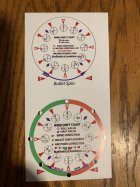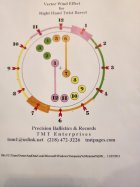I post about group shapes on here a fair bit and how I use them to read tune as well as conditions. Many on here are already familiar with these but I haven't seen it posted in quite a while. They are a useful tool. I hear a lot of talk about full value and half value, etc. The reality is that crosswinds also have a vertical component to them depending on rh or lh twist. There are very, very few LH twist bbls on this side of the pond or anywhere in the accuracy game but if you were to have one, everything is just opposite from the chart.
You have to test but as a general rule, I find that a true crosswind(full value) has about 1/3rd as much vertical as horizontal to it...without getting into spin drift and other factors.
Just a good guide here. This is why you see me post about wind generally NOT creating groups diagonally up and to the right. The other way, yes,(up and left). So, even with a one hole group, you can use this to help with how well tuned the rifle is or isn't. Especially so if the groups around it are predictable but that gets deeper than intended for this thread.

You have to test but as a general rule, I find that a true crosswind(full value) has about 1/3rd as much vertical as horizontal to it...without getting into spin drift and other factors.
Just a good guide here. This is why you see me post about wind generally NOT creating groups diagonally up and to the right. The other way, yes,(up and left). So, even with a one hole group, you can use this to help with how well tuned the rifle is or isn't. Especially so if the groups around it are predictable but that gets deeper than intended for this thread.















